Have a Mold Problem? Call us now
Have a Mold Problem? Call us now
Struggling with mold at home or work? This guide outlines a comprehensive mold removal protocol to help you address the issue effectively. Learn how to conduct initial mold assessments, ensure safety, contain the problem, and perform thorough cleaning and prevention.
Table of Contents
ToggleA thorough initial assessment by certified professionals is crucial for effective mold remediation, identifying moisture sources and extent of contamination.
Safety precautions, including the use of appropriate personal protective equipment (PPE), are essential to minimize mold exposure risks during the remediation process.
Post-remediation inspection and testing validate the effectiveness of mold removal, ensuring the area is safe for occupancy and preventing future infestations.
Mold is a type of fungus that thrives in environments where moisture is present, making both homes and workplaces susceptible to its growth. Mold can appear as visible patches or stains on walls, ceilings, and other surfaces, especially in areas affected by water damage or high humidity. However, not all mold is visible—microscopic mold spores can float through the air, settling on damp surfaces and quickly multiplying when conditions are right.
Mold growth is fueled by three main factors: moisture, a suitable temperature (often humid or cool), and a food source such as wood, drywall, or dust. When these elements combine, mold colonies can develop rapidly, sometimes within 24 to 48 hours. Because mold spores are always present in the air, controlling moisture is the most effective way to prevent mold from taking hold indoors.
If you notice signs of mold or a persistent musty odor, it’s important to act quickly. Mold remediation services specialize in identifying the source of moisture, assessing the extent of mold growth, and implementing strategies to remove mold and prevent its return. Addressing mold promptly not only protects your property but also ensures a healthier indoor environment for everyone.
Exposure to mold can lead to a range of health problems, particularly for individuals with compromised immune systems, allergies, or pre-existing respiratory conditions. Mold toxicity is a serious concern, as inhaling or coming into contact with mold spores can trigger allergic reactions, skin rashes, and respiratory symptoms such as coughing, sneezing, and nasal congestion. Some people affected by mold may also experience headaches, sore throats, or more severe health effects like asthma attacks and lung infections.
For those with higher risk factors—such as young children, the elderly, or anyone with chronic health issues—mold exposure can result in more significant health issues, including persistent respiratory infections and, in rare cases, neurological symptoms. Because mold can grow unnoticed behind walls or under flooring, it’s essential to address any signs of mold growth as soon as possible.
Professional mold remediation services are equipped to safely remove mold and reduce the risk of ongoing exposure. By taking swift action to remove mold and prevent its return, you can protect yourself and others from the potential health effects associated with mold toxicity and ensure a safer living or working environment.
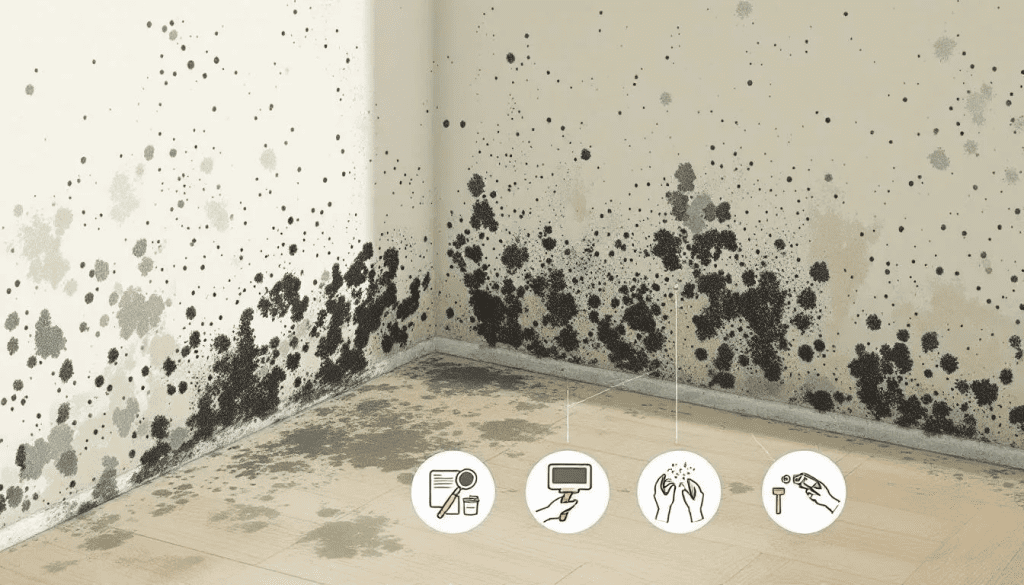
The first step in any effective mold removal protocol is a thorough initial assessment:
This critical stage should be conducted by a certified mold inspection service, independent from any mold remediation services efforts.
A professional inspection ensures an unbiased evaluation of the mold problem. The assessment should document the area affected by mold, including the size and extent of damage.
This sets the stage for an effective remediation process.
When selecting a certified inspection service, check references and consider professionals affiliated with professional organizations to ensure credibility and expertise.
The assessment should:
Identify and document moisture sources and the extent of contamination.
Locate leaks, condensation issues, or other water sources, since moisture drives mold growth and this is key for long-term control.
Evaluate affected building materials.
Suggest preventative maintenance strategies to prevent future problems.
Specialists in mold inspection and remediation are commonly listed in phone books and online directories, making it easier to find qualified professionals.
Techniques such as moisture mapping and infrared cameras can reveal hidden water within walls, ceilings, and other components. This comprehensive assessment results in a detailed report with recommendations for remediation. This report serves as a roadmap, guiding the subsequent steps in the mold removal protocol.
Mold can affect a wide variety of building materials, especially those that are porous and can easily absorb moisture. Commonly affected materials include drywall, carpeting, insulation, and ceiling tiles. When heavy mold growth occurs on these porous materials, it often penetrates deep into the structure, making it difficult to clean and requiring removal and replacement to fully eliminate the contamination.
Hard surfaces such as wood, concrete, and metal can also support mold colonies if moisture is present, but these materials are generally easier to clean and disinfect during the mold remediation process. However, if mold growth is extensive or the material has been compromised, even hard surfaces may need to be removed.
The remediation process involves a careful assessment to identify all contaminated materials, followed by the safe removal and disposal of items that cannot be cleaned. Addressing moisture issues and thoroughly cleaning all affected areas are essential steps to prevent mold from returning and to protect the integrity of your building materials.
Safety is paramount when dealing with mold. PPE minimizes the risk of mold exposure, which can cause allergic reactions and respiratory problems. PPE includes:
Gloves (to prevent direct mold contact, which can cause allergic reactions or skin irritation)
Goggles (ensure they do not have open vent holes, as these can allow small particles or mold spores to enter)
Full face respirator
Safety glasses (should not have open vent holes for the same reason)
Disposable clothing, all designed to protect individuals involved in the remediation process and mitigate mold toxicity.
Recommended protective equipment for handling mold includes:
Long protective gloves that reach the middle of the forearm to ensure no skin is exposed to potentially harmful spores. Gloves are essential to avoid mold contact, which can lead to allergic reactions or skin irritation.
Properly fitted goggles to prevent dust and small particles from entering the eyes during remediation. Avoid goggles with open vent holes, as these do not provide adequate protection against mold spores.
N-95 respirators for small mold cleanups, as they filter out 95% of airborne particulates.
Half face respirators for more extensive mold situations to provide comprehensive protection.
Disposable clothing is another crucial component of PPE, preventing the transfer of mold spores from the remediation site to other areas. Sealing gaps in protective clothing with duct tape ensures complete coverage and protection. Following these safety guidelines significantly reduces the risk of mold exposure.
Containment is a vital step in mold remediation, ensuring that mold spores do not spread to unaffected areas of the property. Setting up containment adheres to safety standards and ensures thorough and effective remediation. Proper containment protects building occupants from mold exposure and related health risks. The contaminated area must be properly sealed and isolated to prevent the spread of mold spores.
Containment involves sealing the affected area to stop mold spores from spreading during the cleanup process. This is typically done using barriers such as plastic sheeting to create an isolated environment. Key steps include:
Sealing all supply and air vents within the containment area with polyethylene sheeting
Minimizing contaminant migration
Maintaining a controlled atmosphere
Facilitating effective humidity management and drying
Another critical aspect of containment is maintaining the containment area under negative pressure. This ensures that it remains lower than the pressure in surrounding areas. Negative pressure keeps airborne mold spores contained within the remediation area, preventing their spread to other parts of the building. This controlled environment is essential for successful mold remediation and protecting the health of building occupants.
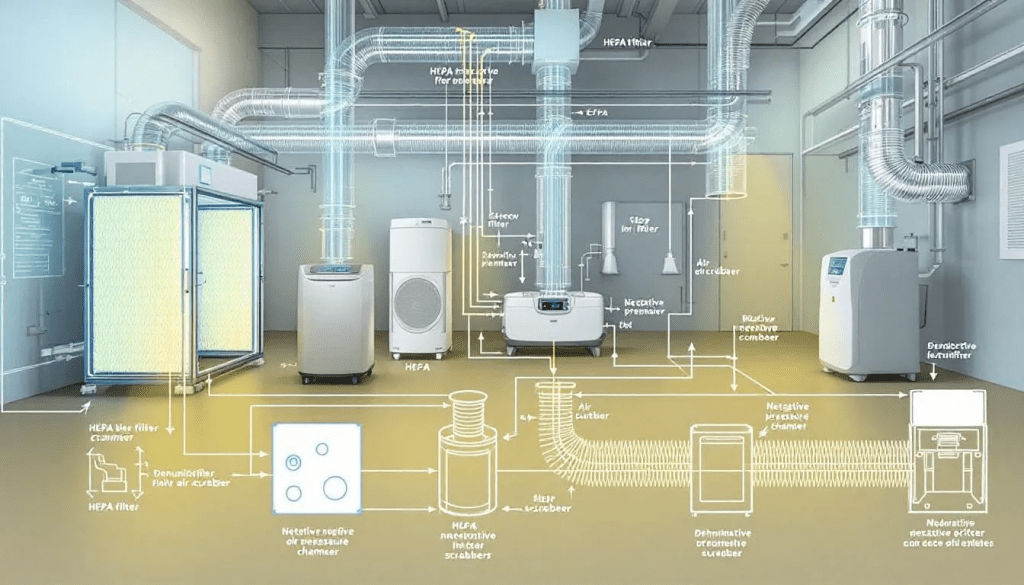
Effective air filtration and ventilation are key components of mold remediation. Air scrubbers play a crucial role in this process by:
Filtering out airborne mold spores
Enhancing indoor air quality
Reducing health effects
Mitigating cross-contamination by containing airborne mold spores within the affected area during the remediation process.
Air scrubbers equipped with HEPA filters are particularly effective, capturing particles as small as 0.3 microns and effectively trapping mold spores that are typically 10 to 30 microns. Selecting the right air scrubber or hepa vacuum is essential, considering factors such as filtration efficiency, coverage area, and moisture control features. HEPA vacuums are also used during final cleanup to remove dust and prevent the spread of mold spores, ensuring filter integrity and safe operation in contaminated environments. Portable air scrubbers are ideal for localized mold issues, while in-duct air scrubbers are suitable for extensive areas or recurrent mold problems.
Proper ventilation also plays a critical role in mold remediation. Well-ventilated affected by mold areas help dissipate remaining mold spores and prevent further growth. After air filtration, it is important to inspect and clean the HVAC system to prevent mold spores from circulating throughout the building. Effective air filtration combined with adequate ventilation creates a healthier indoor environment and aids the overall cleanup process.
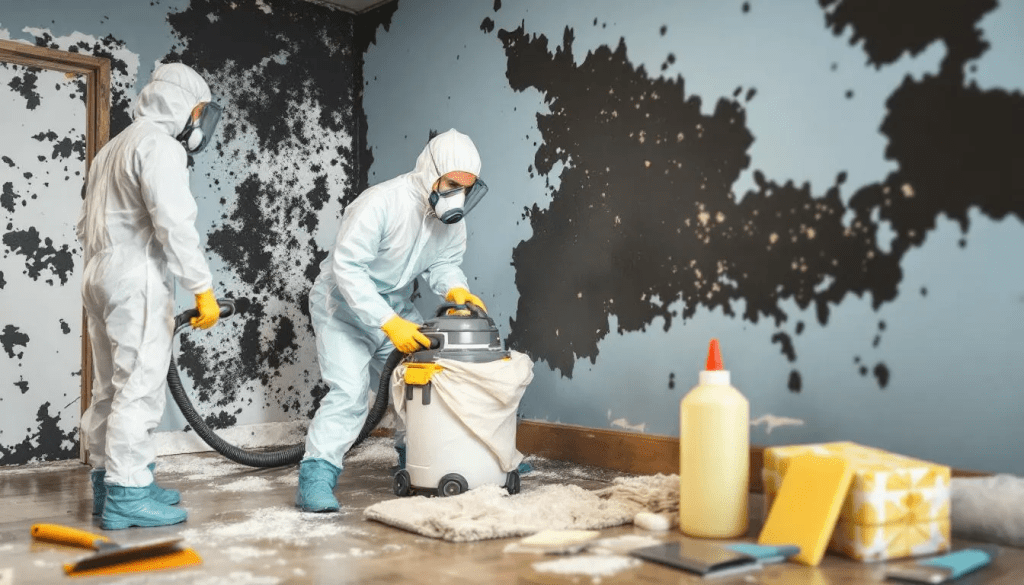
The removal of contaminated materials is a critical step in the mold remediation process. According to guidelines, mold-infested materials should ideally be removed when the heavy mold growth exceeds ten square feet. Common targets for removal include porous materials like drywall and ceiling tiles, which can harbor black mold within their structure, especially when mold growing is present. Mold can also hide in empty spaces or crevices within walls or materials, making thorough removal essential to ensure all mold is addressed.
During the removal process, it’s essential to properly seal and dispose of affected materials to minimize the risk of spreading mold spores. The damaged building materials should be:
packaged
sealed
sprayed down
disposed of according to safety regulations This ensures that mold spores do not contaminate other areas during the cleanup process.
If you need to remove items with sentimental value, consult a specialist to ensure proper restoration and preservation of these belongings.
Removal of affected building materials must adhere to EPA standards for safety and effectiveness. Porous materials that have been wet and contaminated with mold must be discarded to remove completely further growth. Following these guidelines ensures effective mold removal and prevents future infestations.
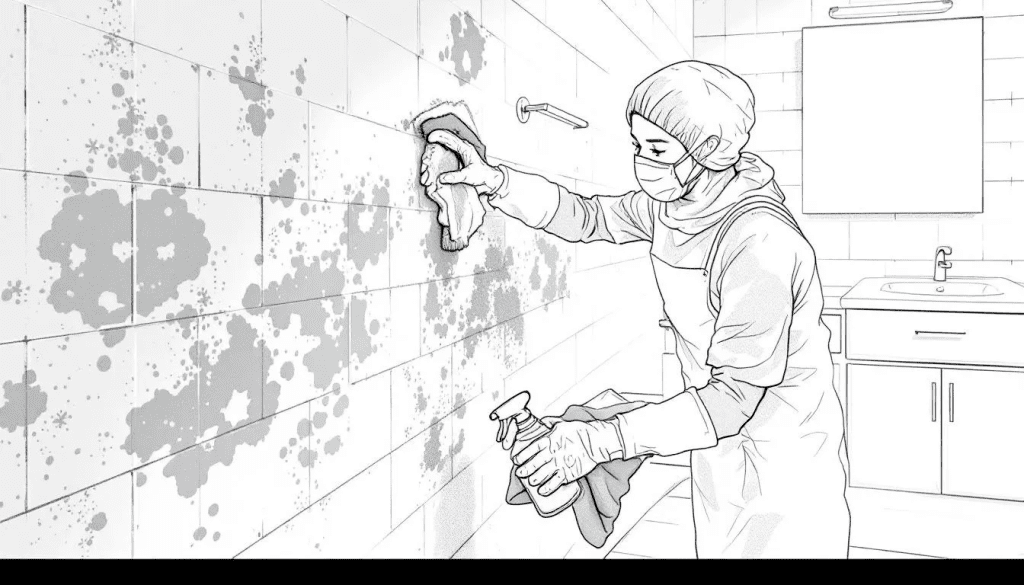
Proper techniques for cleaning up mold are essential, and professional mold remediation methods—such as wet vacuums, damp wiping, HEPA vacuuming, and safe disposal of contaminated materials—should be considered to ensure thorough removal and safety.
After removing contaminated materials, the next step is cleaning and disinfecting the remaining surfaces. Hard surfaces should be damp wiped with water or detergent to effectively remove mold. Different molds may require different cleaning approaches, so it is important to tailor your method accordingly. Scrub mold off using a mixture of detergent and water for thorough cleaning, including removing mold from any affected areas. Remember that some mold and spores may not be visible to the naked eye, so thorough cleaning is necessary even if surfaces appear clean.
Applying a biocide during remediation kills mold spores. Applying a mold-resistant coating after a biocide prevents future infestations. This additional step helps to create a barrier against mold growth, ensuring long-term mold control.
Furnishings and personal items often require specialized clean techniques to ensure they are free of mold spores. Take care to avoid stirring spores into the air during cleaning. For rug cleaning, especially with valuable or heavily contaminated rugs, professional services are recommended to prevent mold damage and ensure proper restoration. Following these cleaning and disinfecting procedures ensures effective mold cleanup and that items are properly cleaned.
Controlling moisture is crucial for effective mold management. Quickly repairing plumbing leaks can help prevent mold growth. Effective drying and dehumidification reduce indoor humidity levels below 50% to inhibit mold growth.
Strategically placing high-powered air movers enhances air circulation and speeds up drying. The drying process typically takes between 3 to 5 days, depending on the extent of the water damage. Conduct moisture testing to ensure materials are sufficiently dried, preventing future mold growth.
Ensure affected areas are thoroughly dried before starting restoration work after mold remediation in any moldy area. This step is crucial for long-term mold control and preventing future infestations.
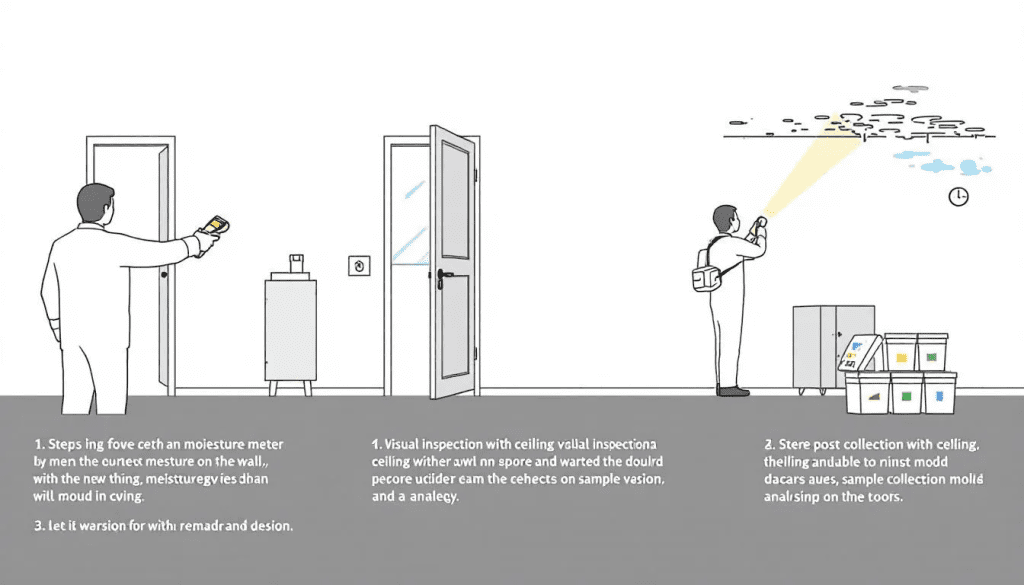
A thorough post-remediation inspection eliminates health risks associated with remaining mold. A Post Remediation Verification (PRV) Assessment includes a visual inspection and mold clearance testing to confirm effective remediation. This assessment confirms the success of the mold remediation process.
Mold clearance testing involves:
Collecting air and surface samples to determine the presence of mold spores before and after remediation.
Conducting a PRV assessment to confirm successful remediation.
Issuing a report that certifies the environment has returned to normal fungal ecology levels.
This certification assures that the area is safe for occupancy.
Post-remediation clearance testing ensures mold has been effectively removed and the area is safe for occupancy. This step is crucial for maintaining a healthy indoor environment post-remediation.
Consult a licensed contractor to assess and execute repairs on mold-damaged structures. This ensures repairs are done correctly and the building is restored to its original condition by a restoration company. Document all mold damage, property damage, and art restoration efforts for insurance claims and future reference. It is also important to coordinate with your insurance company to streamline the insurance claim process and ensure all necessary documentation is provided.
After repairs and restoration, working with professionals who hold restoration certification ensures that all work meets industry standards and proper protocols are followed.
Recommendations for dealing with mold damage:
Replace building materials if they are severely damaged by mold and cannot be effectively restored.
Avoid painting over moldy surfaces, as this can lead to paint peeling later.
Ensure proper restoration and repair to maintain the building’s integrity and prevent future mold problems.
Consult your insurance company and file an insurance claim for property damage caused by mold.
Preventing mold growth starts with controlling moisture throughout your property. Ensure that all areas, especially those prone to dampness like bathrooms, kitchens, and basements, are well-ventilated and kept dry. Promptly repair any water leaks and address sources of condensation to reduce the risk of mold spores settling and multiplying.
Regular inspection and cleaning are key to mold control. Use a HEPA vacuum to remove dust and mold spores from floors, carpets, and upholstery, and clean surfaces with appropriate cleaning products. In commercial buildings, it’s important to follow mold prevention guidelines set by professional or government organizations, such as the Environmental Health and Safety department, to maintain a safe indoor environment for all building occupants.
By taking proactive steps—such as routine inspections, maintaining low indoor humidity, and ensuring proper ventilation—you can prevent mold growth, reduce the risk of mold exposure, and minimize the need for costly mold remediation services in the future. Consistent mold cleanup and maintenance are essential for protecting both your property and your health.
Effective mold removal requires a systematic approach, starting with a thorough initial assessment and followed by proper safety precautions, containment setup, air filtration, and ventilation. The removal of contaminated materials, cleaning and disinfecting surfaces, and drying the area are crucial steps in the remediation process. Post-remediation inspection and testing ensure that the mold has been effectively removed, and restoration and repair complete the process.
Following this comprehensive guide can help prevent mold from growing and protect the health of building occupants. By understanding and implementing these steps, you can tackle mold head-on and maintain a healthy indoor environment.
Remember, mold remediation is not just about cleaning; it’s about creating a safe and healthy space. Take action today and ensure your home or building is mold-free.
A certified mold inspection is crucial as it provides an unbiased evaluation of mold issues, which is essential for efficient remediation. This thorough assessment helps protect your health and property by addressing mold problems effectively.
For mold remediation, it is essential to wear gloves, goggles, respirators, and disposable clothing to ensure your protection during the process. Proper PPE helps minimize exposure to mold and its potential health risks.
Containment is essential in mold remediation as it prevents mold spores from dispersing to unaffected areas, safeguarding both the building occupants’ health and minimizing the extent of contamination during cleanup.
Post-remediation clearance testing is essential to confirm that mold has been successfully eradicated and that the area is safe for reoccupancy. It provides peace of mind that the remediation was effective.
Documenting mold damage and restoration efforts is essential for supporting insurance claims and ensuring a record for future reference. This practice helps substantiate your case and provides valuable information should any related issues arise.